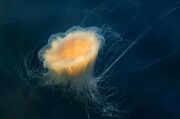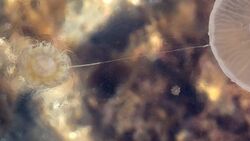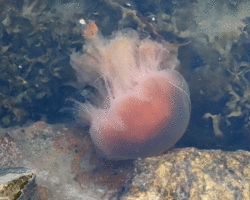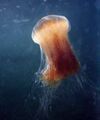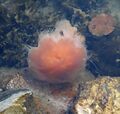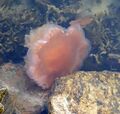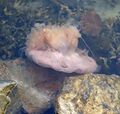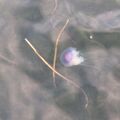Biology:Lion's mane jellyfish
| Lion's mane jellyfish | |
|---|---|
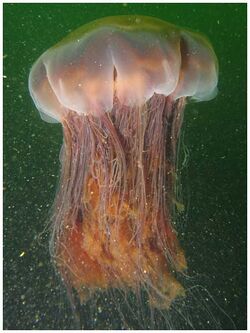
| |
| Scientific classification | |
| Domain: | Eukaryota |
| Kingdom: | Animalia |
| Phylum: | Cnidaria |
| Class: | Scyphozoa |
| Order: | Semaeostomeae |
| Family: | Cyaneidae |
| Genus: | Cyanea |
| Species: | C. capillata
|
| Binomial name | |
| Cyanea capillata | |
The lion's mane jellyfish (Cyanea capillata), also known as the giant jellyfish, arctic red jellyfish, or the hair jelly,[1] is one of the largest known species of jellyfish. Its range is confined to cold, boreal waters of the Arctic, northern Atlantic, and northern Pacific Oceans. It is common in the English Channel, Irish Sea, North Sea, and in western Scandinavian waters south to Kattegat and Øresund. It may also drift into the southwestern part of the Baltic Sea (where it cannot breed due to the low salinity). Similar jellyfish – which may be the same species – are known to inhabit seas near Australia and New Zealand. The largest recorded specimen was measured off the coast of Massachusetts in 1870 and had a bell with a diameter of 210 centimetres (7 feet) and tentacles around 36.6 m (120 ft) long.[2] Lion's mane jellyfish have been observed below 42°N latitude for some time in the larger bays of the east coast of the United States.
The lion's mane jellyfish uses its stinging tentacles to capture, pull in, and eat prey such as fish, zooplankton, sea creatures, and smaller jellyfish.[3]
Taxonomy
The taxonomy of the Cyanea species is not fully agreed upon; some zoologists have suggested that all species within the genus should be treated as one. Two distinct taxa, however, occur together in at least the eastern North Atlantic, with the blue jellyfish (Cyanea lamarckii Péron & Lesueur, 1810) differing in color (blue, not red) and smaller size (10–20 cm [3 7⁄8–7 7⁄8 inches] diameter, rarely 35 cm [14 inches]). Populations in the western Pacific around Japan are sometimes distinguished as Cyanea nozakii, or as a subspecies, C. c. nozakii. In 2015, Russian researchers announced a possible sister species, Cyanea tzetlinii found in the White Sea, but this has not yet been recognized by other authoritative databases such as WoRMS or ITIS.[4]
Description
Lion's mane jellyfish (Cyanea capillata) are named for their showy, trailing tentacles reminiscent of a lion's mane. They can vary greatly in size: although capable of attaining a bell diameter of over 2 m (6 ft 7 in), those found in lower latitudes are much smaller than their far northern counterparts, with a bell about 50 cm (20 in) in diameter. Juveniles are lighter orange or tan, very young lion's manes are occasionally colorless and adults are red and darken as they age.
The bell of the lion's mane jellyfish is scalloped into eight lobes (lappets), each lobe containing from 70 to 150 tentacles,[5][6] arranged in four fairly distinct rows. Along the bell margin is a balance organ at each of the eight indentations between the lobes – the rhopalium – which helps the jellyfish orient itself. From the central mouth extend broad frilly oral arms with many stinging cells.[7] Closer to its mouth, its total number of tentacles is around 1,200.[8]
The long, thin tentacles which emanate from the bell's subumbrella have been characterised as “extremely sticky”; they also have stinging cells. The tentacles of larger specimens may trail as long as 30 m (100 ft) or more, with the tentacles of the longest known specimen measured at 36.6 m (120 ft) in length, although it has been suggested that this specimen may actually have belonged to a different Cyanea species.[9] This unusual length – longer than a blue whale – has earned it the status of one of the longest known animals in the world.[10]
Ecology
As coldwater species, these jellyfish cannot cope with warmer waters. The jellyfish are pelagic for most of their lives but tend to settle in shallow, sheltered bays toward the end of their one-year lifespan. In the open ocean, lion's mane jellyfish act as floating oases for certain species, such as shrimp, medusafish, butterfish, harvestfish, and juvenile prowfish, providing both a reliable source of food and protection from predators [citation needed].
Behavior and reproduction
Lion's mane jellyfish remain mostly very near the surface, at no more than 20 m (66 ft) depth. Their slow pulsations weakly drive them forward, so they depend on ocean currents to travel great distances. The jellyfish are most often spotted during the late summer and autumn, when they have grown to a large size and the currents begin to sweep them to shore. Unlike most jellyfish, they are completely solitary and rarely travel in groups
Like other jellyfish, lion's manes are capable of both sexual reproduction in the medusa stage and asexual reproduction in the polyp stage.[11] Lion's mane jellyfish have four different stages in their year-long lifespan: a larval stage, a polyp stage, an ephyrae stage, and the medusa stage.[11] The female jellyfish carries its fertilized eggs in its tentacle, where the eggs grow into larva. When the larva are old enough, the female deposits them on a hard surface, where the larva soon grow into polyps. The polyps begin to reproduce asexually, creating stacks of small creatures called ephyrae.[12] The individual ephyrae break off the stacks, where they eventually grow into the medusa stage and become full-grown jellyfish.[13]
Sting and human contact
Human encounters with the jellyfish can cause temporary pain and localized redness.[14] In normal circumstances, however, and in healthy individuals, the stings of the jellyfish are not known to be fatal; vinegar can be used to deactivate the nematocysts. If there is contact with a large number of tentacles, however, medical attention is recommended after exposure.
There may be a significant difference between touching a few tentacles with fingertips at a beach and accidentally swimming into the jellyfish. The initial sensation is more strange than painful and feels like swimming into warmer and somewhat effervescent water. Some minor pain will soon follow. Normally, there is no real danger to humans (with the exception of people suffering from special allergies). But in cases when someone has been stung over large parts of their body by not just the longest tentacles but the entire jellyfish (including the inner tentacles, of which there are around 1,200[8]), medical attention is recommended as systemic effects can be present.[15] Although rare, in deep water, severe stings can also cause panic followed by drowning.[16][8]
On a July day in 2010, around 150 beachgoers were stung by the remains of a lion's mane jellyfish that had broken up into countless pieces in Wallis Sands State Beach, Rye, New Hampshire, in the United States. Considering the size of the species, it is possible that this incident was caused by a single specimen.[17]
In popular culture
The lion's mane jellyfish appears in the Sherlock Holmes short story "The Adventure of the Lion's Mane" published in The Case-Book of Sherlock Holmes. Holmes discovers at the end of the story that the true killer of a professor who died shortly after going swimming (shouting "the lion's mane" before he succumbed) was actually this jellyfish. Suspicion was originally laid upon the professor's rival in love, until the latter was similarly attacked (he survived, although badly stung). In the context of the story, it is only because the school professor has a weak heart that he succumbs, as is confirmed by the survival of the second victim.
A photograph widely distributed on the internet appears to show an anomalously large lion's mane dwarfing a nearby diver by several times. The photo was subsequently shown to be a hoax.[18]
On the popular television program QI, the show claimed that the longest animal in the world was the lion's mane jellyfish. This was later corrected – in 1864, a bootlace worm (Lineus longissimus) was found washed up on a Scottish shore that was 55 m (180 feet) long. (That claim has its critics: because bootlace worms can easily stretch to several times their natural length, it is possible the worm did not actually grow to be that length.)[19]
Predators
Seabirds, larger fish such as ocean sunfish, other jellyfish species, and sea turtles will only attack juveniles or smaller specimens while a fully grown adult is incapable of being eaten, due to their massive size and the abundance of stinging tentacles they possess, although both adults and juveniles have been documented eaten by anemones.[11] The leatherback sea turtle feeds almost exclusively on them in large quantities during the summer season around Eastern Canada.[20] The jellyfish themselves feed mostly on zooplankton, small fish, ctenophores, and moon jellies.[21]
Gallery
References
- ↑ Hair Jelly (Cyanea capillata) . Australian Venom Research Unit.
- ↑ "Jellyfish 'largest in captivity'" (in en-GB). 2010-07-22. https://www.bbc.com/news/uk-england-humber-10733328.
- ↑ "Lion's Mane Jellyfish : Discovery Channel". Dsc.discovery.com. 2013-05-23. http://dsc.discovery.com/tv-shows/north-america/animals/lions-mane-jellyfish.htm.
- ↑ Glafira D. Kolbasova; Arthur O. Zalevsky; Azamat R. Gafurov; Philipp O. Gusev; Margarita A. Ezhova; Anna A. Zheludkevich; Olga P. Konovalova; Ksenia N. Kosobokova et al. (2015). "A new species of Cyanea jellyfish sympatric to C. capillata in the White Sea". Polar Biol. 38 (9): 1439–1451. doi:10.1007/s00300-015-1707-y.
- ↑ "Lion's Mane Jellyfish". Scubatravel.co.uk. http://www.scubatravel.co.uk/lionsmane2.html.
- ↑ "Lions Mane Jellyfish - Types Of Jellyfish". 8 January 2011. http://www.typesofjellyfish.net/lions_mane_jellyfish/lions_mane_jellyfish.html.
- ↑ Kozloff, Eugene (2003). Seashore Life of the Northern Pacific Coast. University of Washington Press. pp. 54, 56 (1983 edition). ISBN 978-0295960845.
- ↑ 8.0 8.1 8.2 "15 Facts About the Lion's Mane Jellyfish". 15 February 2015. http://mentalfloss.com/article/61609/15-facts-about-lions-mane-jellyfish.
- ↑ McClain, Craig R.; Balk, Meghan A.; Benfield, Mark C.; Branch, Trevor A.; Chen, Catherine; Cosgrove, James; Dove, Alistair D.M.; Gaskins, Lindsay C. et al. (2015-01-13). "Sizing ocean giants: patterns of intraspecific size variation in marine megafauna" (in en). PeerJ 3: e715. doi:10.7717/peerj.715. ISSN 2167-8359. PMID 25649000.
- ↑ "Lion's Mane Jellyfish – Reference Library". redOrbit. https://www.redorbit.com/reference/lions_mane_jellyfish/.
- ↑ 11.0 11.1 11.2 "Lions Mane Jellyfish". Types Of Jellyfish. http://www.typesofjellyfish.net/lions_mane_jellyfish/lions_mane_jellyfish.html.
- ↑ "SCDNR – Jelly fish". Dnr.sc.gov. http://www.dnr.sc.gov/marine/pub/seascience/jellyfi.html.
- ↑ "Open ocean – Jellyfish life cycle – Te Ara Encyclopedia of New Zealand". Teara.govt.nz. 2009-03-02. http://www.teara.govt.nz/en/open-ocean/2/2.
- ↑ "Lion's Mane Jellyfish". Jellyfishfacts.net. http://www.jellyfishfacts.net/lions-mane-jellyfish.html.
- ↑ Mahon, Andrew; Mallinson, Tom E (2020). "Lion's mane jellyfish sting". International Paramedic Practice 10 (2): 46–48. doi:10.12968/ippr.2020.10.2.46. ISSN 2052-4889.
- ↑ "Jellyfish stings - Symptoms and causes". https://www.mayoclinic.org/diseases-conditions/jellyfish-stings/symptoms-causes/syc-20353284.
- ↑ "150 Stung By Jellyfish At Rye Beach – New Hampshire News Story – WMUR Manchester". Wmur.com. 2010-07-21. http://www.wmur.com/news/24341753/detail.html.
- ↑ "Picture of Giant Lion's Mane Jellyfish - Facts - Hoax Or Fact". http://www.hoaxorfact.com/pranks/picture-of-giant-lion-s-mane-jellyfish-facts.html.
- ↑ Carwardine, M. 1995. The Guinness Book of Animal Records. Guinness Publishing. p. 232.
- ↑ Heaslip SG, Iverson SJ, Bowen WD, James MC (2012) Jellyfish Support High Energy Intake of Leatherback Sea Turtles (Dermochelys coriacea): Video Evidence from Animal-Borne Cameras. PLoS ONE 7(3): e33259. doi:10.1371/journal.pone.0033259
- ↑ "Giant Jellyfish". Extremescience.com. http://www.extremescience.com/zoom/index.php/life-in-the-deep-ocean/60-giant-jellyfish.
Other sources
- British Marine Life Study Society – C. capillata and C. lamarcki
- Marine Life Information (UK)
- Marine Biological Laboratory (Massachusetts)
- Pacific Coast jellies
External links
| Wikimedia Commons has media related to Cyanea capillata. |
- Photos of Lion's mane jellyfish on Sealife Collection
Wikidata ☰ Q522939 entry
